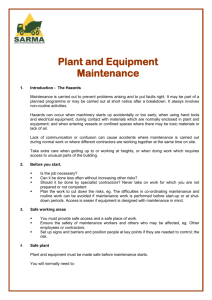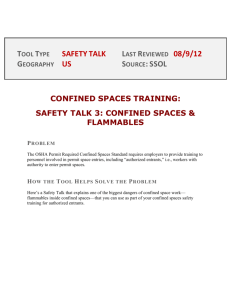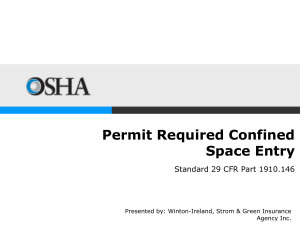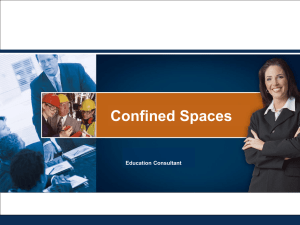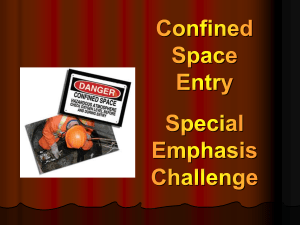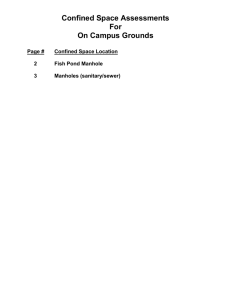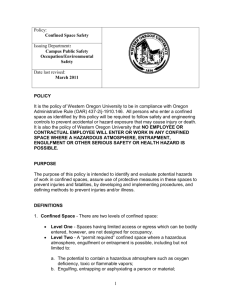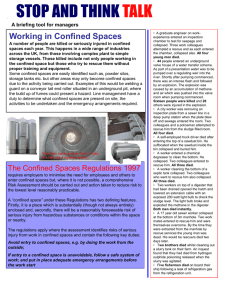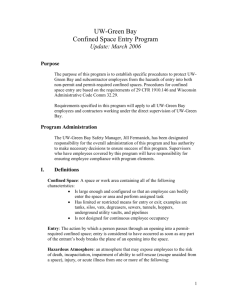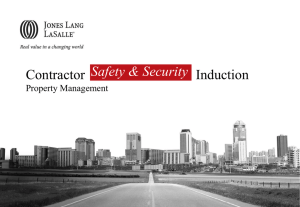Confined Space Entry
advertisement
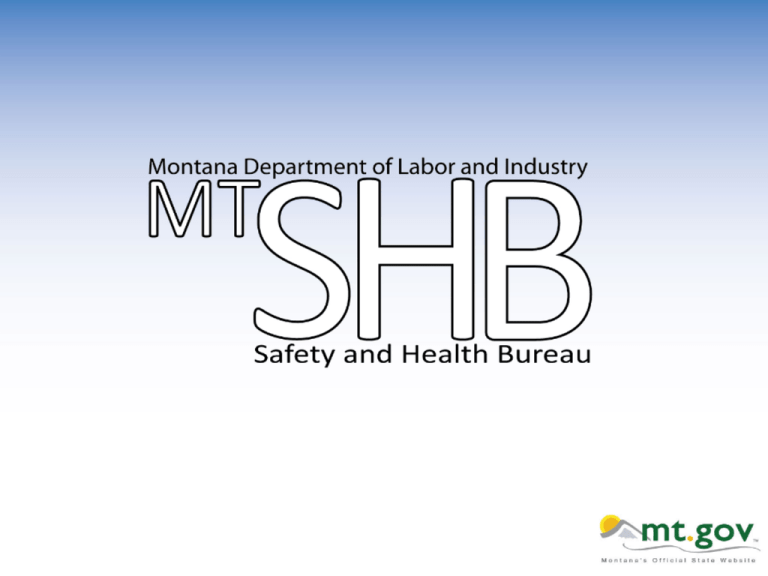
Confined Space Entry Confined Space (1) Large enough for an employee to bodily enter and perform work AND (2) Has limited or restricted entry or exit AND (3) Is not designed for continuous employee occupancy Permit Required Confined Space A confined space that: (1) contains or has a potential to contain a hazardous atmosphere OR (2) has the potential for engulfment OR (3) Has an internal configuration that could trap or asphyxiate OR (4) Contains any other recognized serious safety or health hazard Confined Space Question… • Why are we entering this space? Limited Or Restricted Entry • Any space where an occupant o o o o o Must crawl, climb, twist Be constrained in a narrow opening Follow a lengthy path Exert unusual effort to enter or leave May become trapped Entrance may become sealed or secured against opening from inside Confined Spaces Hazardous Atmosphere • Potential exposure to o Risk of death o Incapacitation o Impairment of ability to self-rescue o Injury o Acute illness • If none of the above o Does not apply to this standard Reclassify • Reclassify to a non-permit space if All potential for a hazardous atmosphere is eliminated AND o All other hazards and potential hazards are eliminated/controlled o Air & Oxygen • Air and oxygen are NOT synonymous. • Air contains o o o o 20.9% oxygen 78.1% nitrogen 1% argon Trace amounts of other gases Hazardous Atmosphere • Flammable gas, vapor, or mist in excess of 10 percent of its lower flammable limit (LFL) • Airborne combustible dust at a concentration that meets or exceeds its LFL o Or visibility 5’ or less Hazardous Atmosphere • Atmospheric oxygen concentration below 19.5 percent or above 23.5 percent • Atmospheric concentration of any toxic substance for which a dose or a permissible exposure limit is published • Any other atmospheric condition that is IMMEDIATELY DANGEROUS TO LIFE OR HEALTH. (IDLH) Delayed Threat • Cadmium vapor and hydrogen fluoride o May seem ok; immediate symptoms go away o Fatal 12 to 72 hours later Conditions That Can Cause Oxygen Deficiency • Adsorption by porous surfaces o Activated charcoal • Consumed by chemical reactions o Rusting o Fermentation • Displaced o Inert gasses Argon CO2 Nitrogen Conditions That Can Cause Oxygen Enrichment • Poorly designed or malfunctioning O2 storage or dispensing equipment • Leaks from oxy-acetylene welding or cutting equipment o Couplings, fittings hoses • Ventilating with pure oxygen Flammable Atmospheres • Vapor burns, not liquid • Flammability based on o o Amount of vapor Temperature Tank Residue • Explosions often caused by residue in “empty” tanks or spaces Residue In Tanks 99% Empty TANK SIZE (GALLONS) 50,000 40,000 30,000 20,000 10,000 5,000 2,500 1,000 RESIDUE (GALLONS) 500 400 300 200 100 50 25 10 Upper & Lower Flammable Limits AIR 100% EXPLOSIVE RANGE LEAN 0% 0% RICH 100% GAS LEL UEL Flammable Atmosphere: Propane Flammable Atmospheres Ignition Sources • Open flame • Electrical arcing • Hot surfaces o Light bulbs • Static electricity • Frictional sparks • Chemical reactions 230o C Control Of Ignition Sources • • • • • • Non-sparking tools Approved electrical equipment Purged & pressurized equipment Intrinsically safe equipment Explosion proof equipment Vessel inerting Control Of Ignition Sources: Hot Work Precautions • Hot work permits • Welding & cutting precautions o o Control of torches & control valves Hoses & regulators In good condition Inspected Minimal tape o Fire prevention & protection Toxic Atmospheres TOXIC: • Harmful, destructive • Deadly • Poisonous (THE AMERICAN HERITAGE DICTIONARY) Sources of Toxic Atmospheres • Products stored in space • Work being performed in space o o Painting, cleaning & degreasing Welding, cutting & brazing • Adjacent areas o Toxins enter & accumulate o Leaching o Chemicals dumped into sewers, streams Toxic Gasses • Irritant Gas o o Serious effects may be delayed Examples Ammonia, chlorine, sulfur dioxide, ozone, nitrogen dioxide • Asphyxiate Gas o o Smothers due to lack of oxygen Two classes Simple asphyxiates Chemical asphyxiates Simple Asphyxiates Displaces oxygen: • Acetylene • Argon • Ethane • Ethylene • Helium • • • • • Hydrogen LP gas Methane Neon Nitrogen Chemical Asphyxiates Cause asphyxiation through biochemical reaction • Hydrogen sulfide • Carbon monoxide • Hydrogen cyanide Engulfment "The surrounding and effective capture of a person" by • A liquid OR • Finely divided (flowable) solid Engulfment • Quicksand effect • Material drawn from bottom • Bridges created by air pockets Air Pocket Mechanical Hazards • Manually isolate each piece of equipment o Prevent vapor leaks, flashbacks, etc. • All pipes must be physically disconnected or isolation blanks bolted in place o o Closing valves not sufficient Inspect & test for leakage • Also consider steam valves, pressure lines, chemical transfer pipes Lockout - Tagout • Render ALL hazardous equipment related to space inoperable o Including accidental startup by others Refer to Lockout/Tagout Standard: 1910.147 Control, Isolation Methods • • • • • • Lockout/tagout Purging Block & bleed Inerting Ventilating Flushing Noise • Noise usually intensified in spaces o Exposure may be higher than in open environment • May disrupt verbal communication o Especially with attendant Air Testing Instruments • Many different kinds of instruments • Results not instantaneous o Delay for portable instruments 30-60 seconds • Assure properly calibrated • Proper care & maintenance o Per manufacturer Air Testing Instruments • Understand use & limitations Accuracy may be +/- 2%, 5%… May be affected by extremes of temperature o May be affected by rich CO2 atmosphere o May only operate properly within certain temperatures and relative humidity o o Air Testing • Test in order o o o • • • • Oxygen Flammables Toxins Test at various levels Test various places Continuously monitor Test around cover before opening Air Testing Alarm Devices • ”Alarm only" devices which do not provide readings are not acceptable o o For initial (pre-entry) or Periodic (assurance) testing • Not enough information to establish acceptable entry conditions • Combination units may be acceptable o Benefit of automatic alarming at predetermined value. Ventilation Equipment • Wide variety of types of ventilation equipment o o o Size & portability Air volume capabilities Power sources Ventilation Only Entry Required • Demonstrate: only hazard is actual or potential hazardous atmosphere • Demonstrate: continuous forced air ventilation alone is sufficient to maintain safe entry • Develop monitoring and inspection data to support these demonstrations Hazard Control Hierarchy • Eliminate hazard o o Engineering controls Process modification • Substitute less hazardous o o o Materials Methods Techniques • Personal protective equipment Personal Protective Equipment • • • • • Proper fit Cleaning & maintenance Replacement Proper use Will not interfere with movement within space • Employee training Respiratory Protection • Vast selection o o o Types, styles Limitations Specific uses • Have selection made by qualified person Permit-required Spaces General Requirements • Evaluate: • Identify all confined spaces • Evaluate to determine if any spaces are permit required confined spaces. Permit-required Spaces General Requirements • Notify employees of o o o Existence Location and Danger • Post signs There, and there, and over there... Permit-required Spaces General Requirements • If employees will enter permit spaces: o Develop & implement a written permit space program Written Program • Ensure that EVERY confined space is o o Evaluated as a possible permit space Reevaluated when its uses or surroundings change. Entry “IS CONSIDERED TO HAVE OCCURRED AS SOON AS ANY PART OF THE ENTRANT'S BODY BREAKS THE PLANE OF AN OPENING INTO THE SPACE” Permit Required Confined Space Entry Team • • • • Entrant Attendant Entry supervisor Rescuers Rescuers • 60% OF CONFINED SPACE VICTIMS ARE WOULD BE RESCUERS (NIOSH STUDY) Dial 911 - ? • • • • Must be informed of hazards Must have access to all permit spaces Must be trained Should be available o Make arrangements BEFORE need arises Non-entry Rescue • Use non-entry rescue whenever possible • Use retrieval systems or methods whenever an entrant enters a permit space o Unless the retrieval equipment would increase the overall risk of entry or would not contribute to the rescue of the entrant Non-entry Rescue • A mechanical device must be available for rescue for vertical type permit spaces more than 5 feet deep. Entry Permit • Actual document • Contains specific required information about entry • Provides history of entry Enter • Retain for at least 1 year space #12 QUESTIONS ???? SANDRA A. MIHALIK Safety & Health Specialist Montana Safety & Health Bureau 406.444.6418 e-mail: smihalik@mt.gov
